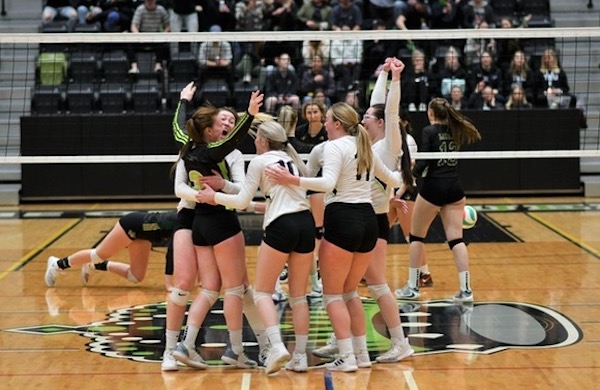Alberta
RDP Queens take their 20th ACAC title at home. Off to National Championships

Queens drop Rustlers in four, earn ACAC gold and trip to nationals
Brent Forster – Red Deer Polytechnic Athletics
Red Deer, AB – For the first time since 2014/2015, the Red Deer Polytechnic Queens Volleyball team has won Alberta Colleges Athletic Conference (ACAC) gold.
“I’ve always wanted to win a provincial title,” said Tess Pearman, a Bachelor of Education Elementary student. “The last regular season we had, we came so close. Coming into this year, that was our goal the whole season.”
In 2019/2020, the Queens earned ACAC silver and Canadian Collegiate Athletic Association (CCAA) national bronze. Then COVID-19 shutdown the 2020/2021 season.
In front of an energetic home crowd, the Queens were even with the Lakeland College Rustlers after two sets, but found an extra gear to win the next two sets and match (25-23, 23-25, 25-14 and 25-20).
“When you get down to the last match of the year between two first place teams in the league, it’s going to be a battle,” said Chris Wandler, Red Deer Polytechnic Queens Volleyball Interim Head Coach. “From the end of our last regular season match when we went five [sets] against Lethbridge and they battled us in the quarter-final, and again last night, that prepared us for this atmosphere.”

Pearman (8)
In a close first set, a stuff block from outside hitter Pearman bumped the RDP Queens ahead 11-10. Lakeland’s Jenay Varga kept her team close. With her fifth kill, the outside hitter had the Rustlers even 22-22. Ultimately, a dump ball from RDP setter Emma Letkeman sealed a 25-23 decision.
Lakeland outside hitter Mackenzie Yole’s third kill knotted up the second set 7-7. The teams traded points to 18-18. Rustlers setter Jana Laing continued the strong connection with Varga, who rattled off three consecutive kills to solidify a 25-23 win.
With a trio of serves from middle Sydney Rix, the RDP Queens captured a 9-4 edge in the third set. RDP’s Vanessa Loos entered the match and had an ace, which pushed the Queens ahead by nine (18-9).
“In a tough situation, we executed at a high level when we needed to and that was the key piece,” added Wandler. “It shows the experience and tenacity that this group has.”
The home team maintained that momentum and a late kill by Jaiden Ferguson, her ninth, helped the Polytechnic pick up a 25-14 victory.

Ferguson (9)
“Fergie had a hot hand last match, so she deserved the start,” said Wandler. “She got off to a little rocky start, but she persevered through that. She just needed to chip in where she could.”
Lakeland’s Avery Bates lifted her team to an early 5-3 margin in the fourth set with her seventh kill. The Queens started to climb back into the frame. RDP went up 14-10 off Pearman’s 12th kill from the left. The Polytechnic continued to push and solidified a 25-20 win, earning ACAC gold.
“To win this championship and to win it at home … I couldn’t ask for anything better,” said Pearman.
The Lakeland College Rustlers picked up silver.
Ferguson contributed 13 kills for the Queens.
North Star Sports Queens Player of the Game Pearman totaled 13 kills, 10 digs, one block, one assist and one of the team’s 10 service aces.
“When we needed a big kill, Tess got it,” said Wandler. “That just gave everyone a spark.”

Domoney (3)
When Pearman went up to accept her top player award, she insisted that Domoney join her.
“Kaylee, player of the game, for sure,” added Pearman. “She saves our butt every game and she holds our team together. She is an amazing player and deserves the recognition.”
Libero Kaylee Domoney was outstanding and picked up 17 digs.
“We haven’t played defence like that all year, mainly because we executed offensively so well. When you match up in championship time versus three defending teams, you have to match them dig for dig,” explained Wandler. “Our back row did a phenomenal job. Kaylee is our rock and everything we do is based upon her.”
Anna Carlson had 12 kills (0.455 hitting percentage) and five of the Queens’ 10 aces.
Rustlers Player of the Match Laing accumulated 35 assists and four digs. Teammate Varga had 18 kills, 10 digs and three of the Rustlers’ six aces. Yole added nine kills and Bates chipped in with eight.
The RDP Queens have won 20 ACAC gold medals.
“We had to earn this spot and that gives us a sense of pride to represent our conference – the best conference in the country,” said Wandler of the team’s trip to nationals. “It means a lot to represent those other 13 colleges in Charlottetown.”
The Red Deer Polytechnic Queens will compete at the CCAA Women’s Volleyball National Championship from March 25-27 in Prince Edward Island. Holland College will host the prestigious event.
“Our game against TKU really helped us. That was probably the hardest game I’ve ever played in my entire life – mentally draining and being down and able to come back set us up well for today,” said Pearman. “No more easy games. We have to fight for every point.”
Alberta
Ottawa-Alberta agreement may produce oligopoly in the oilsands

From the Fraser Institute
By Jason Clemens and Elmira Aliakbari
The federal and Alberta governments recently jointly released the details of a memorandum of understanding (MOU), which lays the groundwork for potentially significant energy infrastructure including an oil pipeline from Alberta to the west coast that would provide access to Asia and other international markets. While an improvement on the status quo, the MOU’s ambiguity risks creating an oligopoly.
An oligopoly is basically a monopoly but with multiple firms instead of a single firm. It’s a market with limited competition where a few firms dominate the entire market, and it’s something economists and policymakers worry about because it results in higher prices, less innovation, lower investment and/or less quality. Indeed, the federal government has an entire agency charged with worrying about limits to competition.
There are a number of aspects of the MOU where it’s not sufficiently clear what Ottawa and Alberta are agreeing to, so it’s easy to envision a situation where a few large firms come to dominate the oilsands.
Consider the clear connection in the MOU between the development and progress of Pathways, which is a large-scale carbon capture project, and the development of a bitumen pipeline to the west coast. The MOU explicitly links increased production of both oil and gas (“while simultaneously reaching carbon neutrality”) with projects such as Pathways. Currently, Pathways involves five of Canada’s largest oilsands producers: Canadian Natural, Cenovus, ConocoPhillips Canada, Imperial and Suncor.
What’s not clear is whether only these firms, or perhaps companies linked with Pathways in the future, will have access to the new pipeline. Similarly, only the firms with access to the new west coast pipeline would have access to the new proposed deep-water port, allowing access to Asian markets and likely higher prices for exports. Ottawa went so far as to open the door to “appropriate adjustment(s)” to the oil tanker ban (C-48), which prevents oil tankers from docking at Canadian ports on the west coast.
One of the many challenges with an oligopoly is that it prevents new entrants and entrepreneurs from challenging the existing firms with new technologies, new approaches and new techniques. This entrepreneurial process, rooted in innovation, is at the core of our economic growth and progress over time. The MOU, though not designed to do this, could prevent such startups from challenging the existing big players because they could face a litany of restrictive anti-development regulations introduced during the Trudeau era that have not been reformed or changed since the new Carney government took office.
And this is not to criticize or blame the companies involved in Pathways. They’re acting in the interests of their customers, staff, investors and local communities by finding a way to expand their production and sales. The fault lies with governments that were not sufficiently clear in the MOU on issues such as access to the new pipeline.
And it’s also worth noting that all of this is predicated on an assumption that Alberta can achieve the many conditions included in the MOU, some of which are fairly difficult. Indeed, the nature of the MOU’s conditions has already led some to suggest that it’s window dressing for the federal government to avoid outright denying a west coast pipeline and instead shift the blame for failure to the Smith government.
Assuming Alberta can clear the MOU’s various hurdles and achieve the development of a west coast pipeline, it will certainly benefit the province and the country more broadly to diversify the export markets for one of our most important export products. However, the agreement is far from ideal and could impose much larger-than-needed costs on the economy if it leads to an oligopoly. At the very least we should be aware of these risks as we progress.

Elmira Aliakbari
Alberta
A Christmas wish list for health-care reform

From the Fraser Institute
By Nadeem Esmail and Mackenzie Moir
It’s an exciting time in Canadian health-care policy. But even the slew of new reforms in Alberta only go part of the way to using all the policy tools employed by high performing universal health-care systems.
For 2026, for the sake of Canadian patients, let’s hope Alberta stays the path on changes to how hospitals are paid and allowing some private purchases of health care, and that other provinces start to catch up.
While Alberta’s new reforms were welcome news this year, it’s clear Canada’s health-care system continued to struggle. Canadians were reminded by our annual comparison of health care systems that they pay for one of the developed world’s most expensive universal health-care systems, yet have some of the fewest physicians and hospital beds, while waiting in some of the longest queues.
And speaking of queues, wait times across Canada for non-emergency care reached the second-highest level ever measured at 28.6 weeks from general practitioner referral to actual treatment. That’s more than triple the wait of the early 1990s despite decades of government promises and spending commitments. Other work found that at least 23,746 patients died while waiting for care, and nearly 1.3 million Canadians left our overcrowded emergency rooms without being treated.
At least one province has shown a genuine willingness to do something about these problems.
The Smith government in Alberta announced early in the year that it would move towards paying hospitals per-patient treated as opposed to a fixed annual budget, a policy approach that Quebec has been working on for years. Albertans will also soon be able purchase, at least in a limited way, some diagnostic and surgical services for themselves, which is again already possible in Quebec. Alberta has also gone a step further by allowing physicians to work in both public and private settings.
While controversial in Canada, these approaches simply mirror what is being done in all of the developed world’s top-performing universal health-care systems. Australia, the Netherlands, Germany and Switzerland all pay their hospitals per patient treated, and allow patients the opportunity to purchase care privately if they wish. They all also have better and faster universally accessible health care than Canada’s provinces provide, while spending a little more (Switzerland) or less (Australia, Germany, the Netherlands) than we do.
While these reforms are clearly a step in the right direction, there’s more to be done.
Even if we include Alberta’s reforms, these countries still do some very important things differently.
Critically, all of these countries expect patients to pay a small amount for their universally accessible services. The reasoning is straightforward: we all spend our own money more carefully than we spend someone else’s, and patients will make more informed decisions about when and where it’s best to access the health-care system when they have to pay a little out of pocket.
The evidence around this policy is clear—with appropriate safeguards to protect the very ill and exemptions for lower-income and other vulnerable populations, the demand for outpatient healthcare services falls, reducing delays and freeing up resources for others.
Charging patients even small amounts for care would of course violate the Canada Health Act, but it would also emulate the approach of 100 per cent of the developed world’s top-performing health-care systems. In this case, violating outdated federal policy means better universal health care for Canadians.
These top-performing countries also see the private sector and innovative entrepreneurs as partners in delivering universal health care. A relationship that is far different from the limited individual contracts some provinces have with private clinics and surgical centres to provide care in Canada. In these other countries, even full-service hospitals are operated by private providers. Importantly, partnering with innovative private providers, even hospitals, to deliver universal health care does not violate the Canada Health Act.
So, while Alberta has made strides this past year moving towards the well-established higher performance policy approach followed elsewhere, the Smith government remains at least a couple steps short of truly adopting a more Australian or European approach for health care. And other provinces have yet to even get to where Alberta will soon be.
Let’s hope in 2026 that Alberta keeps moving towards a truly world class universal health-care experience for patients, and that the other provinces catch up.
-

 Bruce Dowbiggin2 days ago
Bruce Dowbiggin2 days agoHunting Poilievre Covers For Upcoming Demographic Collapse After Boomers
-

 Business2 days ago
Business2 days agoState of the Canadian Economy: Number of publicly listed companies in Canada down 32.7% since 2010
-

 Censorship Industrial Complex1 day ago
Censorship Industrial Complex1 day agoCanadian university censors free speech advocate who spoke out against Indigenous ‘mass grave’ hoax
-

 Alberta2 days ago
Alberta2 days agoHousing in Calgary and Edmonton remains expensive but more affordable than other cities
-

 Alberta2 days ago
Alberta2 days agoWhat are the odds of a pipeline through the American Pacific Northwest?
-

 Business2 days ago
Business2 days agoWarning Canada: China’s Economic Miracle Was Built on Mass Displacement
-

 Agriculture2 days ago
Agriculture2 days agoThe Climate Argument Against Livestock Doesn’t Add Up
-

 International1 day ago
International1 day agoGeorgia county admits illegally certifying 315k ballots in 2020 presidential election







